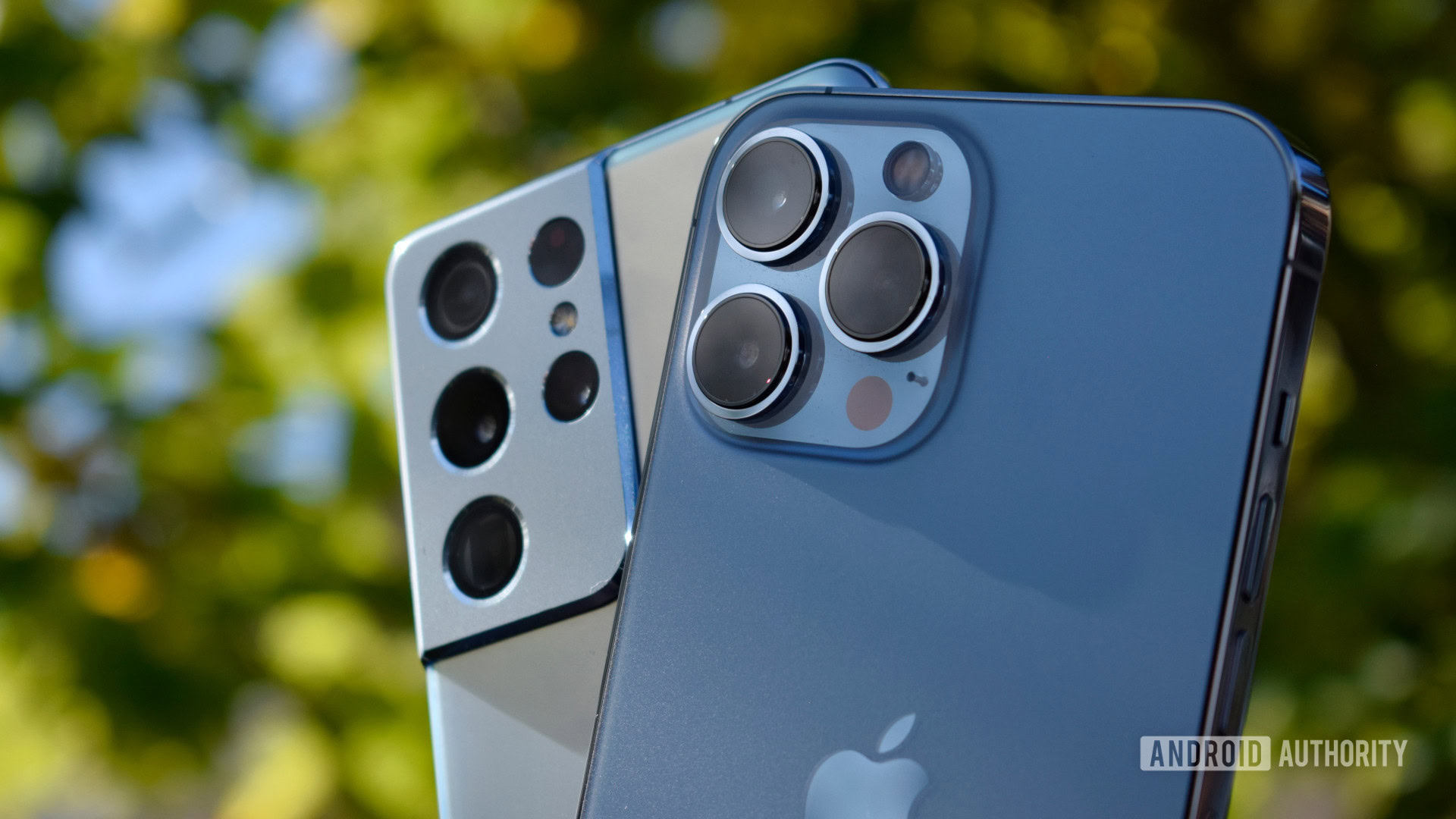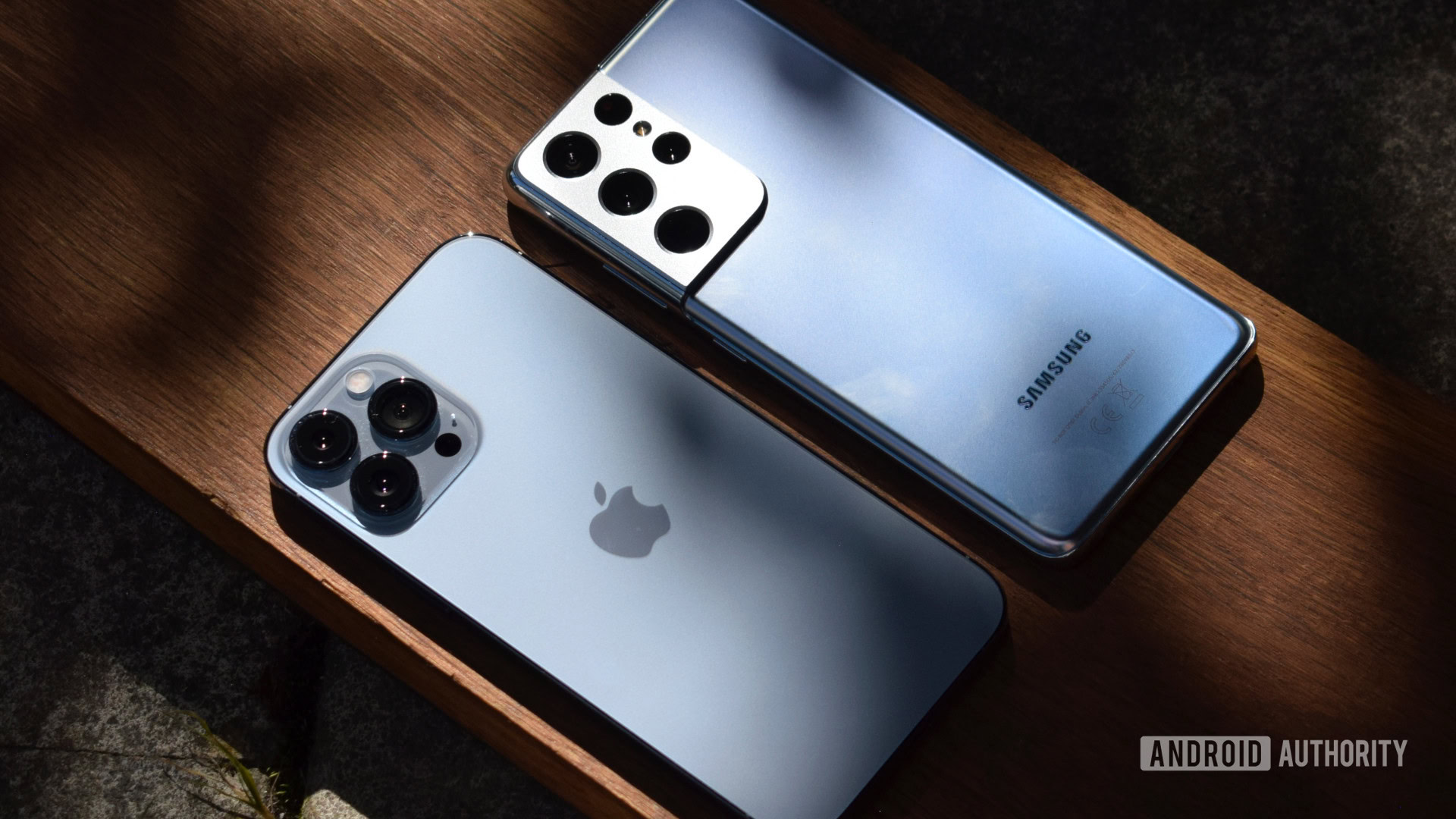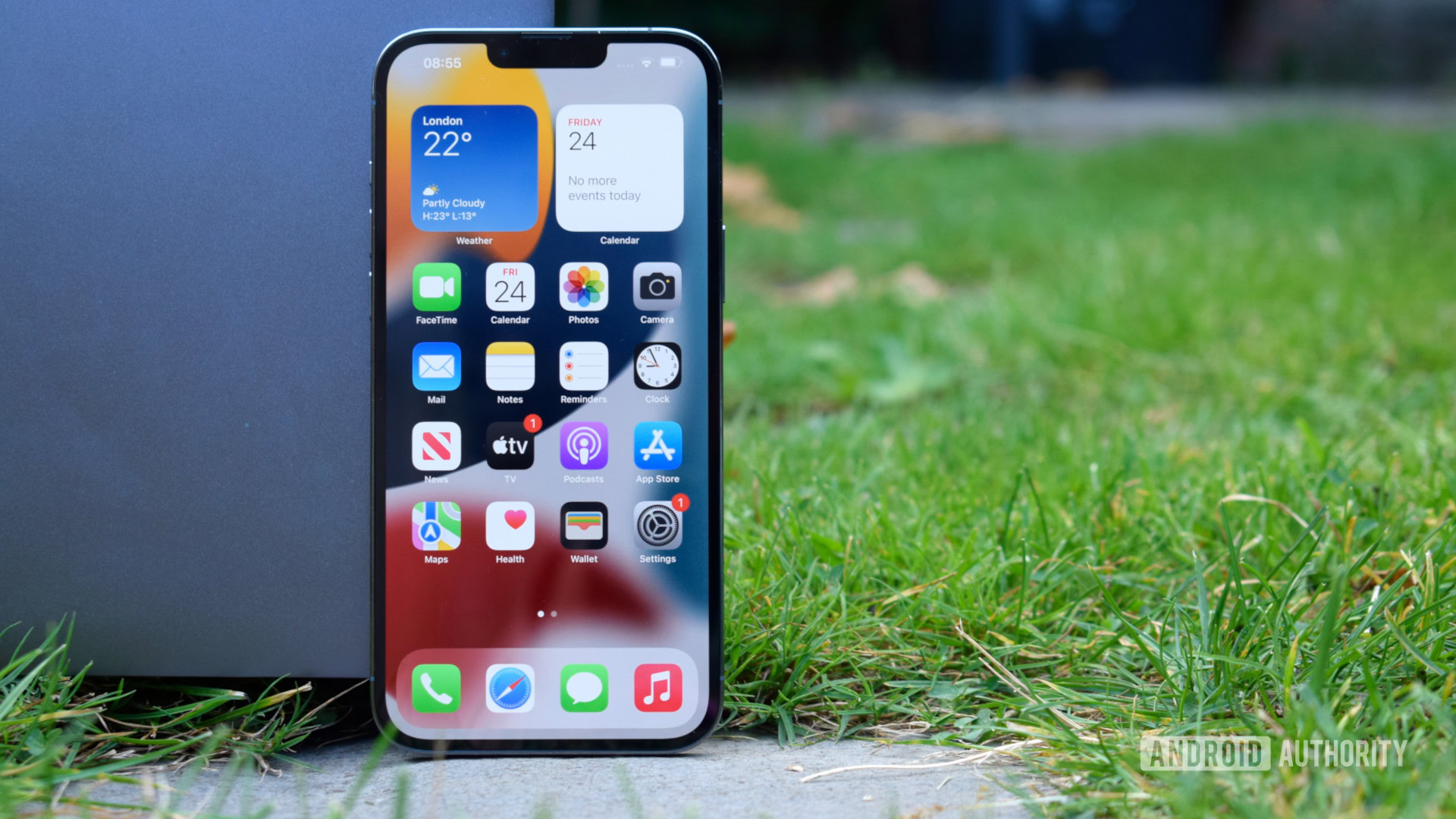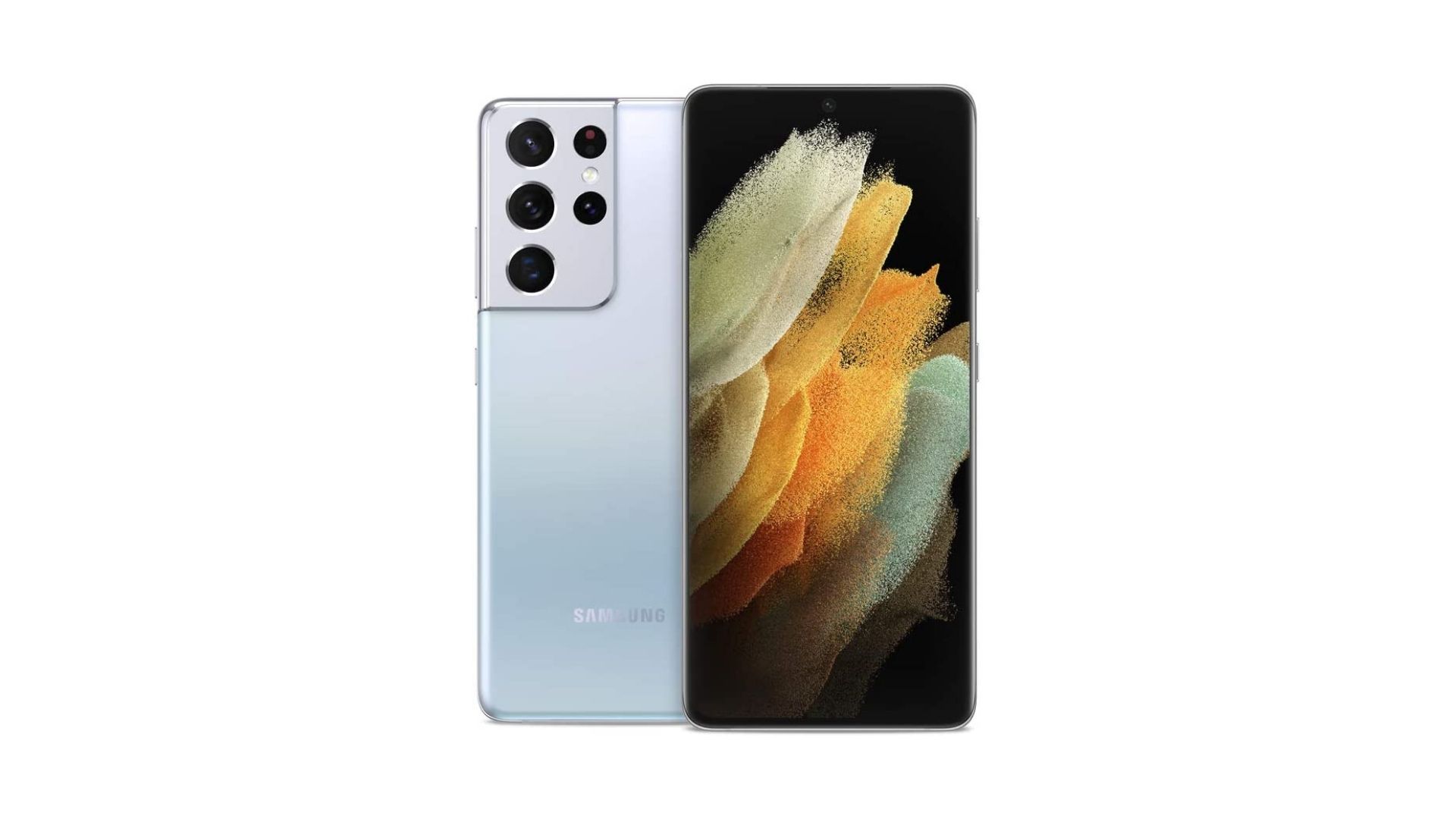Affiliate links on Android Authority may earn us a commission. Learn more.
Camera shootout: Samsung Galaxy S21 Ultra vs Apple iPhone 13 Pro Max

If you’re looking to buy a smartphone that takes the best pictures in the business then the Apple iPhone 13 Pro Max and Samsung Galaxy S21 Ultra are bound to be on your shortlist.
Sporting cutting-edge camera sensor hardware, an array of lenses for flexible shooting, and powerful image processing capabilities, the top-tier iPhone and Galaxy smartphones pride themselves on taking great pictures. Traditionally these brands have been the two to beat but which one is truly the best? We’ve been out taking some snaps to compare the two. Let’s see which phone comes out on top in this Samsung Galaxy S21 Ultra vs iPhone 13 Pro Max camera shootout.
Read more: The best camera phones you can get
Samsung Galaxy S21 Ultra vs iPhone 13 Pro Max camera specs
Before diving into some pictures, here’s a quick rundown of the two phones’ camera specifications gives us some idea about what to expect.
| Samsung Galaxy S21 Ultra | Apple iPhone 13 Pro Max | |
|---|---|---|
Main Camera | Samsung Galaxy S21 Ultra 108MP (12MP binned) f/1.8 aperture 24mm focal length 1/1.33" sensor PDAF, OIS | Apple iPhone 13 Pro Max 12MP f/1.5 aperture 26mm focal length 1/1.66" sensor dual pixel PDAF, sensor-shift OIS |
Ultra-Wide | Samsung Galaxy S21 Ultra 12MP f/2.2 aperture 13mm focal length 1/2.55" sensor dual pixel PDAF | Apple iPhone 13 Pro Max 12MP f/1.8 aperture 13mm focal length 1/3.4" sensor PDAF |
Telephoto zoom | Samsung Galaxy S21 Ultra 10MP f/2.4 aperture 70mm focal length 1/3.24" sensor dual pixel PDAF, OIS 3x zoom | Apple iPhone 13 Pro Max 12MP f/2.8 aperture 77mm focal length 1/3.4" sensor PDAF, OIS 3x zoom |
Periscope zoom | Samsung Galaxy S21 Ultra 10MP f/4.9 aperture 240mm focal length 1/3.24" sensor dual pixel PDAF, OIS 10x zoom | Apple iPhone 13 Pro Max |
Focusing | Samsung Galaxy S21 Ultra Laser AF system | Apple iPhone 13 Pro Max 3D ToF Lidar |
Most notably, Samsung’s Galaxy S21 Ultra boasts a fourth camera compared to the iPhone’s three. This 10x periscope zoom camera offers substantially longer range capabilities than the iPhone 13 Pro Max, which we fully expect to give the handset a boost in quality at very long ranges. Apple may have the nudge in the ultra-wide department though, owing to a much wider aperture for improved light capture.
The iPhone 13 Pro Max also sports a larger main image sensor than last year. This improvement should help close the gap on the Galaxy S21 Ultra’s big sensor, especially when it comes to low light performance. But the proof of the pudding is in the actual images, so let’s dive right in.
Everyday camera samples
As you’d expect from two of the most expensive flagship smartphones around, it’s difficult to take a bad picture with either handset. Generally speaking, white balance, color, exposure, and detail are all exceptional from both camera setups across a wide range of scenarios.
Tthe Galaxy S21 Ultra and iPhone 13 Pro Max are exceptional everyday shooters, but there are some subtle differences.
There are subtle differences though. For starters, Samsung’s main camera lens has a fractionally wider field of view. More importantly, Apple’s color balance is a little more yellow than Samsung’s, which can leave some shots looking a little sickly. However, the phone usually opts for a more reserved but realistic color balance. The Galaxy S21 Ultra offers a fraction more punch in its color palette. It’s not overly aggressive like in previous years and Samsung’s additional pop sometimes works out in the phone’s favor.
Another small difference is that the Galaxy S21 Ultra offers a little bit of a brighter exposure, ensuring the subject is well presented — although the rose picture above shows that this doesn’t always work out for the better, as this can wash out colors. This is particularly noticeable indoors, where subjects shot on the iPhone often appear underexposed and a little more heavily processed, and especially noticeable in the very first picture. But overall these are subtle rather than glaring differences.
Related: Photography terms explained — ISO, aperture, shutter speed, and more
HDR is an area where there is a much more noticeable discrepancy between the two phones. Apple’s implementation is OK but it’s more prone to overblown highlights and under-exposed subjects when shooting against bright backgrounds. Likewise, the iPhone lacks dynamic range and color when shooting against bright sunlight compared to the Samsung Galaxy S21 Ultra. Note the dark shadows in the trees in the second shot below. You wouldn’t complain about this very much when using the iPhone in isolation, but the results are easier to spot stacked up next to Samsung’s flagship.
As expected, there are subtle differences between the two phones for general shooting. HDR aside, these are mostly down to differences in taste and tone rather than obvious examples of superior or inferior camera capabilities. That said, my personal preference leans slightly more towards Samsung’s color and exposure preferences, although there’s really not a huge amount between these two without pixel peeping.
Low light photography
Apple hasn’t officially given out details on the sensors inside the iPhone 13 Pro Max but teardowns reveal it’s using a Sony IMX703 for its bigger main sensor. This camera component measures 1/1.66 inches across. That’s still smaller than the Galaxy S21 Ultra’s main sensor (1/1.33 inches) but not by as much as previous generations. Plus with fewer pixel cell walls, just 12MP versus 108MP, and a wider aperture, the iPhone’s main camera may end up capturing surprisingly similar or even larger amounts of light for low light shooting. Apple claims a 1.5x improvement over last year’s iPhone 12 Pro Max, although I didn’t notice a huge difference between the two.
Check out: Tips for improving smartphone low light photography
Comparing the iPhone 13 Pro Max to the Galaxy S21 Ultra without the use of night mode, it’s clear that Samsung’s flagship again offers slightly brighter exposure and captures marginally more color in low light. However, close examination of the pictures shows far less noise from the iPhone, resulting in a cleaner image and more detail in very low light, although there are also signs of a little more processing and image cleanup too.
Switching on night mode greatly improves the low light quality of both smartphones, albeit at the cost of a little more post-processing. The iPhone 13 Pro Max is still the darker of the two but it’s actually more realistic for the conditions of the scene, although oddly, the first sample of the Nintendo Switch case is overly saturated, while Samsung’s image is a little too flat. These roles reverse in the second snap, where the Galaxy S21 Ultra ramps up the colors while the iPhone is more conservative.
Low light performance ends in a draw.
There are pros and cons to each phone’s low light capabilities. The iPhone is less prone to noise for a quick snap but its pictures come out darker, although you could fix up this exposure manually and probably come out with the best-looking image. Samsung’s low light shots are brighter and better exposed but the phone suffers from much more noise, particularly in the absence of night mode. I’d call this a draw.
Ultra-wide and zoom capabilities
Moving on from the main camera, let’s take a look at the phones’ zoom and ultra-wide capabilities. On paper, we’re fully expecting the Galaxy S21 Ultra to have the edge at long range. But intermediate ranges between 3x and 5x should be a lot closer.
Also read: Camera zoom explained — How optical, digital, and hybrid zoom work
Indeed our assumptions are right. With 3x telephoto lenses and similarly sized sensors on board, both the iPhone 13 Pro Max and Galaxy S21 Ultra hand in high-quality optical zoom details. Even at 5x, there’s very little to tell these two apart, at least in terms of detail. Colors are a bit of a different matter, as we again see a little more yellow in the iPhone’s grass. Similarly, it’s also a little more brightly exposed. The S21 Ultra nails the hues of the golden hour a little better, at least in this example, although to Apple’s credit, colors remain highly consistent across all its camera lenses.
At 10x there’s no competition. While the iPhone’s trees dissolve into blobs, the Galaxy S21 Ultra’s periscope camera continues to extract high-quality detail at long range. The only drawback of this lens is that its colors take on a bit of a warmer hue and are washed out compared to the main and telephoto cameras. But that’s a minor complaint.
The iPhone 13 Pro Max and Galaxy S21 Ultra hand in high-quality optical zoom details.
Turning to ultra-wide cameras, we see the same themes play out in terms of color in this scene. Both lenses offer virtually indistinguishable wide fields of view and act as a major step back from the main sensor. Both cameras offer a virtually identical level of detail and there are some but only minimal signs of lens distortion at the edges too. This is arguably a win for the iPhone, given its wider lens aperture which is notoriously difficult to produce without adding distortion. Samsung’s image is marginally more heavily processed here, giving the illusion of crisper details but it’s a double-edged sword. Anyway, you have to pixel peep to notice.
Comparing a second ultra-wide angle shot showcases how the phones handle color management and HDR a little differently. The iPhone 13 Pro Max retains the same color, exposure, and HDR processing in this scene when moving between the two cameras. Consistency between cameras ensures that your pictures always look their best no matter which lens you decide to shoot with.
By comparison, Samsung’s approach to processing is very different between these two shots. The brand’s more powerful HDR technology kicks in here but the end result is much brighter shadows and an entirely different green color palette when moving between lenses in this example, not to mention a more heavily processed look when cropping in. While the picture definitely isn’t bad, the consistency between lenses is poor and the ultra-wide camera ruins the look of this golden hour photo compared to the main lens.
If you’re after a winner here, the Galaxy S21 Ultra is clearly the more flexible shooter of the two, if only due to the added range of its 10x periscope camera. However, the iPhone 13 Pro Max provides a more consistent experience across its three camera lenses in terms of color processing. There’s definitely something to be said for knowing that your pictures will look equally great no matter which lens you use.
Samsung Galaxy S21 Ultra vs iPhone 13 Pro Max camera shootout: The verdict

The Apple vs Samsung photography battle is always a close-fought affair and this year is no exception. Given that Apple has made iterative rather than revolutionary changes to its iPhone 12 Pro Max formula, the 13 Pro Max remains a competent if not exactly cutting-edge shooter. Still, the results speak for themselves and it’s virtually impossible to take a bad photo with this phone. The phone is also now one of the better handsets on the market when it comes to low light quality. That said, I’m not convinced by the iPhone 13 Pro Max’s propensity for yellows, occasional underexposure, and mediocre HDR capabilities.
Which takes the better pictures?
With its 10x periscope camera and powerful HDR and night mode capabilities onboard, the Galaxy S21 Ultra is still the phone to beat when it comes to shooting flexibility. I’m also a fan of slightly punchier colors and exposure, although you will find instances where the effects are a little overbearing. The handset also isn’t quite as consistent as the iPhone when it comes to switching lenses and I’d give the nudge to Apple’s ultra-wide sensor.
When you’re spending premium smartphone money, you expect high-quality photography and it’s hard to go wrong with either phone. I’d personally pick the Galaxy S21 Ultra as the marginally better shooter, but that’s mostly down to personal preference for the phone’s greater flexibility. Of course, Google’s Pixel 6 Pro isn’t far away now either and should bring another competitive shooting option to the table. We’ll definitely be diving deeper into the capabilities of all these phones later in the year in one of our mega shootouts!

